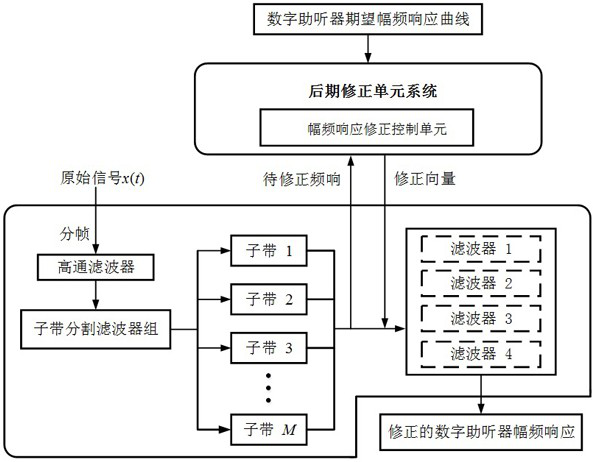A late-stage correction method for low-complexity amplitude-frequency response for digital hearing aids
An amplitude-frequency response and low-complexity technology, applied in the field of signal processing, can solve problems such as inapplicability, inapplicability in real-time, computational complexity and power consumption of digital hearing aids, achieving reduced complexity, good application prospects, and efficient configuration Effect
- Summary
- Abstract
- Description
- Claims
- Application Information
AI Technical Summary
Problems solved by technology
Method used
Image
Examples
Embodiment Construction
[0042] The present invention will be further described below in conjunction with the accompanying drawings.
[0043] Such as figure 1 As shown, the post-correction method of the low-complexity amplitude-frequency response for digital hearing aids of the present invention first removes the DC offset from the original signal through a high-pass filter, and then passes through a sub-band divider composed of a filter bank to obtain several sub-bands , the amplitude-frequency response of several sub-band signals obtained by segmentation and the expected amplitude-frequency response of the digital hearing aid are sent to the post-correction unit system for post-correction of the amplitude-frequency response of the digital hearing aid. The system uses the amplitude-frequency response correction control unit to adaptively Select an appropriate amplitude-frequency response correction method to combine strategies and correction parameters, and finally obtain a corrected amplitude-freque...
PUM
 Login to View More
Login to View More Abstract
Description
Claims
Application Information
 Login to View More
Login to View More - R&D
- Intellectual Property
- Life Sciences
- Materials
- Tech Scout
- Unparalleled Data Quality
- Higher Quality Content
- 60% Fewer Hallucinations
Browse by: Latest US Patents, China's latest patents, Technical Efficacy Thesaurus, Application Domain, Technology Topic, Popular Technical Reports.
© 2025 PatSnap. All rights reserved.Legal|Privacy policy|Modern Slavery Act Transparency Statement|Sitemap|About US| Contact US: help@patsnap.com



